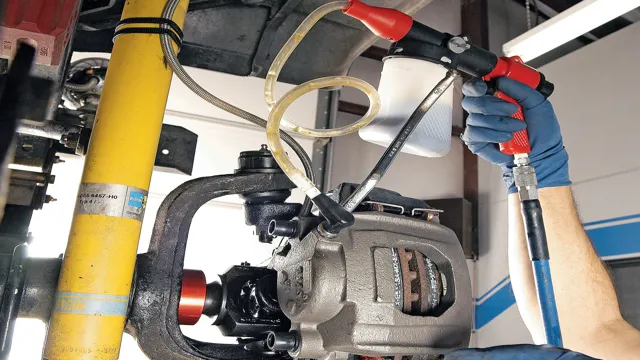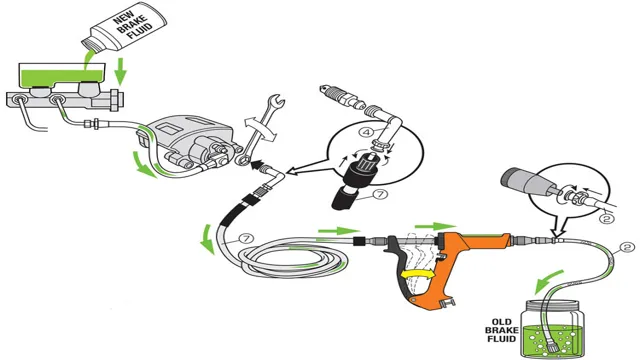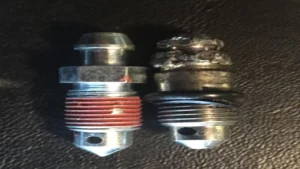Have you ever wondered how mechanics are able to efficiently remove air bubbles from a car’s brake system? The answer is simple: they use a vacuum brake bleeder tool. In this blog post, we’ll explore the inner workings of a vacuum brake bleeder and how it helps to keep your car’s brakes functioning at optimal levels. Imagine a straw sucking liquid from a cup, but instead of a straw, it’s a tool that’s been made to fit into a brake bleed screw opening.
The vacuum brake bleeder employs a similar approach, using negative air pressure to remove air bubbles from the brake system. Keep reading to learn more about how this handy tool works!
Overview
If you’re wondering how a vacuum brake bleeder works, you’re not alone. This tool is crucial for anyone who wants to bleed their brakes easily and efficiently. A vacuum brake bleeder uses a vacuum pump to apply negative pressure to the brake system, which pulls air and fluid from the brake line and expels it into a reservoir.
This process is repeated until all of the air is removed and only clean fluid remains in the brake lines. The vacuum brake bleeder is a great alternative to manually bleeding your brakes, which can be time-consuming and messy. With a vacuum brake bleeder, you can quickly and easily get the job done in no time.
So if you’re looking for a tool that can help you maintain your brakes and keep them in good condition, look no further than a vacuum brake bleeder.
Introduction to Vacuum Brake Bleeder
If you’re sick and tired of manually bleeding your car’s brake system, then a vacuum brake bleeder tool is just what you need. This tool uses vacuum pressure to suck out the air bubbles and moisture from your brake lines, ensuring that your brakes work smoothly and efficiently. With a vacuum brake bleeder, you can perform brake maintenance and repairs without having to rely on a second person to help you.
One of the best things about vacuum brake bleeders is that they are easy to use and don’t require special training or knowledge. All you need to do is attach the tool to the brake bleeder valve, create a vacuum, and watch as the air bubbles get removed. Additionally, using a vacuum brake bleeder can save you time and money in the long run, as it can help prevent expensive brake system repairs.
So, if you want to make brake maintenance a breeze without breaking the bank, consider investing in a vacuum brake bleeder tool today.

Components of a Vacuum Brake Bleeder
Vacuum brake bleeder Overview: A vacuum brake bleeder is a device used to remove air from the brake system of a vehicle. It works by creating a vacuum in the brake lines, which causes air bubbles to be sucked out of the system. The main components of a vacuum brake bleeder include a vacuum pump, a reservoir, hoses, and adapters.
The vacuum pump creates the suction needed to remove air from the brake lines, while the reservoir collects the old brake fluid. The hoses and adapters are used to connect the vacuum pump to the brake lines and allow for a secure seal. When using a vacuum brake bleeder, it is important to follow proper safety procedures and be careful with the brake fluid, which can be harmful if it comes into contact with skin or eyes.
Overall, a vacuum brake bleeder is an essential tool for maintaining a vehicle’s brake system and ensuring safe, reliable operation on the road.
Step-by-Step Guide
Vacuum brake bleeders work by creating negative pressure or a vacuum to remove air bubbles from the brake lines and brake system. The brake bleeder attaches to the brake fluid reservoir and uses a hose to connect to the brake caliper or wheel cylinder where the air bubbles are trapped. Once connected, the vacuum pump produces negative pressure, which pulls the brake fluid through the system and removes all the air bubbles.
With the vacuum brake bleeder, there is no need for a second person to pump and hold the brake pedal, making the brake bleeding process much simpler and more efficient. Additionally, using the vacuum brake bleeder minimizes the chance of introducing more air into the brake system, ensuring that the brakes work perfectly once the system is bled. Overall, the vacuum brake bleeder is an essential tool for maintaining and repairing your vehicle’s braking system, ensuring that it is safe and reliable.
Preparing the Vacuum Brake Bleeder
To prepare the vacuum brake bleeder, start by gathering all necessary tools and equipment. You will need a vacuum pump, a brake bleeder kit, a small container, and a wrench. Next, locate the master cylinder and remove the cover.
Identify the brake fluid reservoir and check the level, ensuring it falls between the minimum and maximum marks. Then proceed to attach the brake bleeder kit to the vacuum pump, making sure the hose is securely attached. Place the small container beneath the bleeder screw and use the wrench to loosen it.
Pump the vacuum pump until the brake fluid is extracted and repeat the process for each brake line until all air pockets have been removed. It is important to keep an eye on the brake fluid level during this process and to top up as needed. Following these steps ensures that your vehicle’s brake system is functioning optimally and that your brakes are ready for use.
Remember to always prioritize safety when performing maintenance on your vehicle’s brake system.
Attaching the Bleeder
Attaching the bleeder to your system is an important step to ensure the proper functioning of your brakes. Here’s how you can do it step-by-step. Firstly, make sure you have the correct bleeder size to match your brake system.
Next, locate the bleeder valve on your brake caliper and remove the dust cap to expose the valve. Place a wrench on the bleeder valve and attach a clear plastic tube securely onto it. The other end of the tube should be submerged in a container filled with brake fluid.
Ensure that the bleeder valve is tightened to prevent air from entering the system. With the tube and container in place, pump the brake pedal until you notice fresh brake fluid flowing through the tube. This is a sign that the system is free from air bubbles and that the bleeder valve is working correctly.
Once you’re done, remove the plastic tube and container and replace the dust cap on the bleeder valve. Remember, air in the brake system can cause brake failure, so ensure that you bleed your brakes regularly to keep them in tip-top condition.
Opening the Bleeder Valve
Opening the bleeder valve is an essential task that ensures the proper functioning of your car’s brake system. If you notice a spongy or low brake pedal, it may be time to bleed the brakes. Here’s a step-by-step guide that you can easily follow.
Firstly, park your car on a flat surface and loosen the lug nuts on the wheel where you’re going to start bleeding the brakes. Then, lift the car and secure it on jack stands. Check your brake fluid level and top it off if necessary.
Locate the bleeder valve on the caliper or wheel cylinder and attach a clear tubing to it. Submerge the other end of the tube in a container filled with brake fluid. Get a helper to sit in the car and press the brake pedal slowly and hold it.
Open the bleeder valve with a wrench and let the brake fluid flow through the tubing until no air bubbles come out. Close the valve and tell your helper to slowly release the brake pedal. Repeat the process until all air is removed from the line.
Finally, tighten the bleeder valve and repeat the process for all four wheels. By following these simple steps, you’ll ensure your car’s brake system remains in proper working order.
Establishing Vacuum Pressure
Establishing vacuum pressure is a crucial step in many industrial applications, including research and manufacturing processes. It involves removing air from a sealed chamber or system to create a low-pressure environment, which is necessary for carrying out specific tasks. Here is a step-by-step guide on how to establish vacuum pressure: First, connect the pump to the chamber using a vacuum hose.
Make sure the pump is turned off before inserting the hose into the chamber. Once connected, start the pump and allow it to run for a few minutes to remove as much air as possible from the chamber. Next, check the pressure gauge to ensure that it is within the desired range.
Adjust the pump speed accordingly to achieve the desired pressure. If the pressure is too high, reduce the pump speed, and if it’s too low, increase it. Repeat the process until the desired level of vacuum pressure is achieved.
It’s crucial to monitor the pressure gauge regularly to ensure it remains within the desired range. Lastly, turn off the pump and disconnect the vacuum hose. Remember to close the valve on the chamber to maintain the pressure.
In conclusion, establishing vacuum pressure is a simple process that requires proper equipment, regular monitoring, and adjustments to achieve the desired results. Following the steps outlined above will ensure that your vacuum system works efficiently and effectively for your industrial or research needs.
Bleeding the Brakes
Bleeding the brake system is a task that can seem daunting, but with the right tools and a little know-how, it can be a straightforward process. Essentially, bleeding your brakes is necessary to remove air bubbles and ensure that your brake pedal feels firm and reliable. To start, gather the right equipment, including a wrench, brake fluid, and a proper braking bleeding kit.
Next, locate the bleed valves on your brake calipers and open them with the wrench. Use the brake bleeding kit to pump fresh brake fluid through the system and expel old fluid until the fluid runs clear. After finishing the bleeding process, tighten the bleed valves, replace the brake fluid cap, and take your car on a test drive to ensure that everything feels and performs correctly.
Taking the time to bleed your brakes can ensure your safety and help you avoid costly repairs down the road. So, if you’re experiencing a soft or unresponsive brake pedal, don’t hesitate to tackle this task head-on and get your brake system back in top condition.
Benefits of Using a Vacuum Brake Bleeder
How does a vacuum brake bleeder work and what are the benefits of using one? A vacuum brake bleeder uses suction to remove air bubbles and old brake fluid from your vehicle’s brake system. This process is much more efficient than traditional brake bleeding techniques because it removes air and fluid at a much faster rate. Plus, it’s much easier to do than trying to bleed your brakes using the manual method, which can take lots of time and effort.
By using a vacuum brake bleeder, you can ensure that your brakes are functioning properly and prevent problems down the line. Not only will this save you time and money, but it will also make your driving experience safer and more enjoyable. So if you’re looking for an easy way to keep your brakes in top condition, consider using a vacuum brake bleeder – your car (and your wallet) will thank you!
Increases Efficiency
One of the biggest advantages of using a vacuum brake bleeder is the increased efficiency it offers. When it comes to bleeding brakes, traditional methods can be time-consuming and require multiple people to complete the job. However, a vacuum brake bleeder eliminates the need for assistance and allows for a more efficient process.
By creating a vacuum inside the brake lines, the bleeder can remove air bubbles and old brake fluid quickly and easily. This not only leads to a more efficient bleeding process but also ensures that the brake system is properly maintained. Investing in a vacuum brake bleeder is a smart choice for anyone looking to save time and improve their brakes’ performance.
Reduces Air in Brake System
Vacuum brake bleeders are an essential tool to ensure the proper functioning of your brake system. One of the most significant benefits of using a vacuum brake bleeder is that it reduces the amount of air in your brake system. This is extremely important because air bubbles in the brake lines can cause sponginess in the brake pedal, which can lead to a decrease in braking power.
The vacuum brake bleeder works by creating a negative pressure environment, which draws out any air that may be trapped in your brake lines. By using a vacuum brake bleeder, you can guarantee that your brakes will be free of air and functioning at their highest level of performance. So, if you want to reduce the risk of spongy brakes and ensure your vehicle’s safety, consider investing in a vacuum brake bleeder.
Conclusion
In conclusion, a vacuum brake bleeder works by using the power of suction to extract air bubbles and impurities from your brake lines. It’s like having a tiny vacuum cleaner precision-engineered to suck only the bad stuff, leaving your brakes feeling like they just came out of a spa. So, if you want your car to stop on a dime (or a nickel, or a penny), make sure to give your brake system the TLC it deserves with a trusty vacuum brake bleeder.
After all, a clean brake system is a happy brake system!”
FAQs
What is a vacuum brake bleeder?
A vacuum brake bleeder is a tool used to flush and bleed brake systems by creating a vacuum to draw air and old brake fluid out of the system.
How does a vacuum brake bleeder work?
A vacuum brake bleeder works by attaching a hose to the brake bleeder valve, creating a vacuum in the brake system, and allowing air and old fluid to be drawn out through the valve.
Can a vacuum brake bleeder be used on all types of vehicles?
Yes, a vacuum brake bleeder can be used on all types of vehicles that have an accessible brake bleeder valve.
Is it necessary to use a vacuum brake bleeder when flushing brake fluid?
No, it is not necessary to use a vacuum brake bleeder, but it can make the job easier and more efficient.
What are the benefits of using a vacuum brake bleeder?
The benefits of using a vacuum brake bleeder include faster and more efficient brake system flushing and bleeding, reduced risk of air pockets in the brake lines, and improved brake performance.
Are there any safety precautions to consider when using a vacuum brake bleeder?
Yes, when using a vacuum brake bleeder, it is important to follow all safety precautions, including wearing gloves and eyewear, ensuring proper ventilation, and using the tool according to manufacturer instructions.
Can a vacuum brake bleeder be used for other automotive systems besides brakes?
Yes, a vacuum brake bleeder can also be used for other automotive systems, such as ABS modules and clutch systems, that have a bleeder valve.






